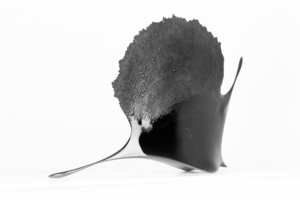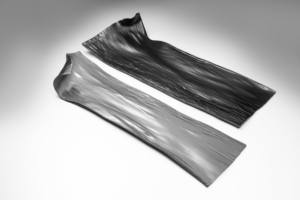Panel Discussion

Comments on the Honorable Mention Winners(1/2)

2019 Flower No.82 「闇咲く」
2019 Flower No.82 “Darkness”
W107 × D20 × H69
2019
藤野 征一郎
FUJINO, Seiichiro (Japan)
OHNISHI ───── Thank you. Let’s move to the Honorable Mention winners. This is ‘2019 Flower No.82 “Darkness”’ by Mr. Seiichiro FUJINO. It looks like an objet d’art. Prof. TANAKA, please comment on this work.
TANAKA ───── Although this work was awarded an Honorable Mention, it was competing for the top prizes until the very end. The artist, Mr. FUJINO, is in his 50s and his artistic production is in full swing. He has received awards many times at many different exhibitions. He is very experienced and I think he is truly in his prime. However, once an artist has established a distinct style, it can be difficult to break away from that. This is a dilemma which many artists face.
The reason why this work is highly evaluated by the Panel members is that we felt the passion and power hidden in this work. Many of the Panel members have seen his works at other exhibitions in Ishikawa in the past, but this work shows a strong ambition which is rarely encountered these days.
Originally, Mr. FUJINO used his own coating techniques to apply unique forms to a carved wooden base. Some of the other features of Mr. FUJINO’s works include the utilization of the delicate texture of the wood grain, with various Shitaji bases and Kawarinuri coating techniques. In this way, he expresses his unique skill in enhancing the texture of the wood. It’s very versatile, and it’s as if he is chattering away through his techniques. Among his recent works, I found this piece a carefree, provocative work. All these factors contributed to the Panel members’ votes for this excellent work.

大王椰子葉鞘の大皿(2点セット)
Big Plate /
Roystonea Regia
W85 × D59 × H12.5
2020
原田 城二
HARADA, Joji (Japan)
OHNISHI ───── Well, shall we move to the next recipient of an Honorable Mention?
Ms. Setsuko YAMADA, could you give us your comments on ‘Big Plate/Roystonea Regia’ by Joji HARADA?
YAMADA ───── Mr. HARADA lives in Okinawa and in January of this year, I came across his work for the first time. Originally he worked in Honshu, but he longed for the simple Urushi coating techniques of Asia and so he came to Okinawa. At that time he saw that the scars of war were still visible there.
One day he was walking in the woods, feeling regretful about cutting down trees in the woods, which had been so damaged by war. As he was wondering what he could do, he came across the fallen leaves of Roystonea Regia, which is a sub-tropical palm tree.
The common, shorter palms grow to the height of 15-20m, and the taller ones which grow on southern roadsides can grow to a height of 40m. The 7m-long leaves fall onto the road and the artist wondered if he would be able to create something with them.
The leaves contain oil, and in order to remove it, he put the leaves into a muddy pond where the bacteria would eat the oil. Afterwards, he dried them and covered the underside of the leaves with Washi paper and linen cloth. Finally, he applied Urushi to the covered surface of the leaves. He created not only works like these large plates but also small plates for individual servings, by using the many native leaves of Okinawa. He exhibited those works at a small gallery, which was my first encounter with them. I was attracted to them because I believe that this is a material for the future.
He said, “I used to worry about harming nature, or cutting its life short by creating my works. However, when I started using fallen leaves, I was relieved and now I feel like I have many more avenues to explore.” This work is about 85cm long and he also said, “I imagine putting three pieces of this leaf plate side by side on a table, presenting a lot of food and sweets while everyone spends their time leisurely together. Tidying up is easy as they are so light and can be placed leaning against the wall, and the small leaf plates can be used to take some food from the leaf platter. In this way, modern life becomes a return to the ancient ways of when people lived close to nature.” I suggested to him to apply for the Ishikawa International Urushi Exhibition, and yesterday I was able to see this work at the Final Assessment.
The work also received the support of the other Panel members to receive an Honorable Mention. I think he will continue to create and improve his Urushi works, using the nature of Okinawa.
I also feel this work is the most appropriate to the COVID-19 Crisis. There might be many more materials for Urushi substrates which we have overlooked. His work shows another way of living with nature, and he received an Honorable Mention with the votes of the other Panel members. He was unsure if his work was good enough, so I hope this will give him more confidence. I’m very happy I could participate in the Final Assessment.
